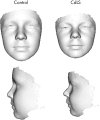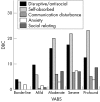Genotype-phenotype correlations of 39 patients with Cornelia De Lange syndrome: the Dutch experience
- PMID: 16236812
- PMCID: PMC2564552
- DOI: 10.1136/jmg.2005.038240
Genotype-phenotype correlations of 39 patients with Cornelia De Lange syndrome: the Dutch experience
Abstract
Background: Cornelia de Lange syndrome (CdLS) is a multiple congenital anomaly syndrome characterised by a distinctive facial appearance, prenatal and postnatal growth deficiency, psychomotor delay, behavioural problems, and malformations of the upper extremities. Recently mutations in NIPBL, the human homologue of the Drosophila Nipped-B gene, were found to cause CdLS. Mutations have been found in 39% of reported cases.
Methods: Patients were enrolled in the study and classified into one of four groups based on clinical examination: classic, mild, possible, or definitively not CdLS. Three dimensional photography was taken of 20 subjects, and compared between groups. Behaviour was assessed with specific attention to autism. We searched for mutations in NIPBL and correlated genotype with phenotype.
Results: : We found mutations in 56% of cases.
Conclusions: Truncating mutations were generally found to cause a more severe phenotype but this correlation was not absolute. Three dimensional facial imaging demonstrated the potential for classifying facial features. Behavioural problems were highly correlated with the level of adaptive functioning, and also included autism. No correlation of behaviour with the type of mutation was found.
Conflict of interest statement
Competing interests: there are no competing interests
References
-
- Gorlin R J, Cohen M M, Hennekam R C M.Syndromes of the head and neck. 4th ed. Oxford Medical Press, New York 2001
-
- Baraitser M, Papavasiliou A S. Mild de Lange syndrome–does it exist? Clin Dysmorphol 19932147–150. - PubMed
-
- Greenberg F, Robinson L K. Mild Brachmann‐de Lange syndrome: Changes of phenotype with age. Am J Med Genet 19893290–92. - PubMed
-
- Halal F, Silver K. Syndrome of microcephaly, Brachmann‐de Lange‐like facial changes, severe metatarsus adductus, and developmental delay: mild Brachmann‐de Lange syndrome? Am J Med Genet 199224381–386. - PubMed
MeSH terms
Substances
LinkOut - more resources
Full Text Sources
Research Materials





